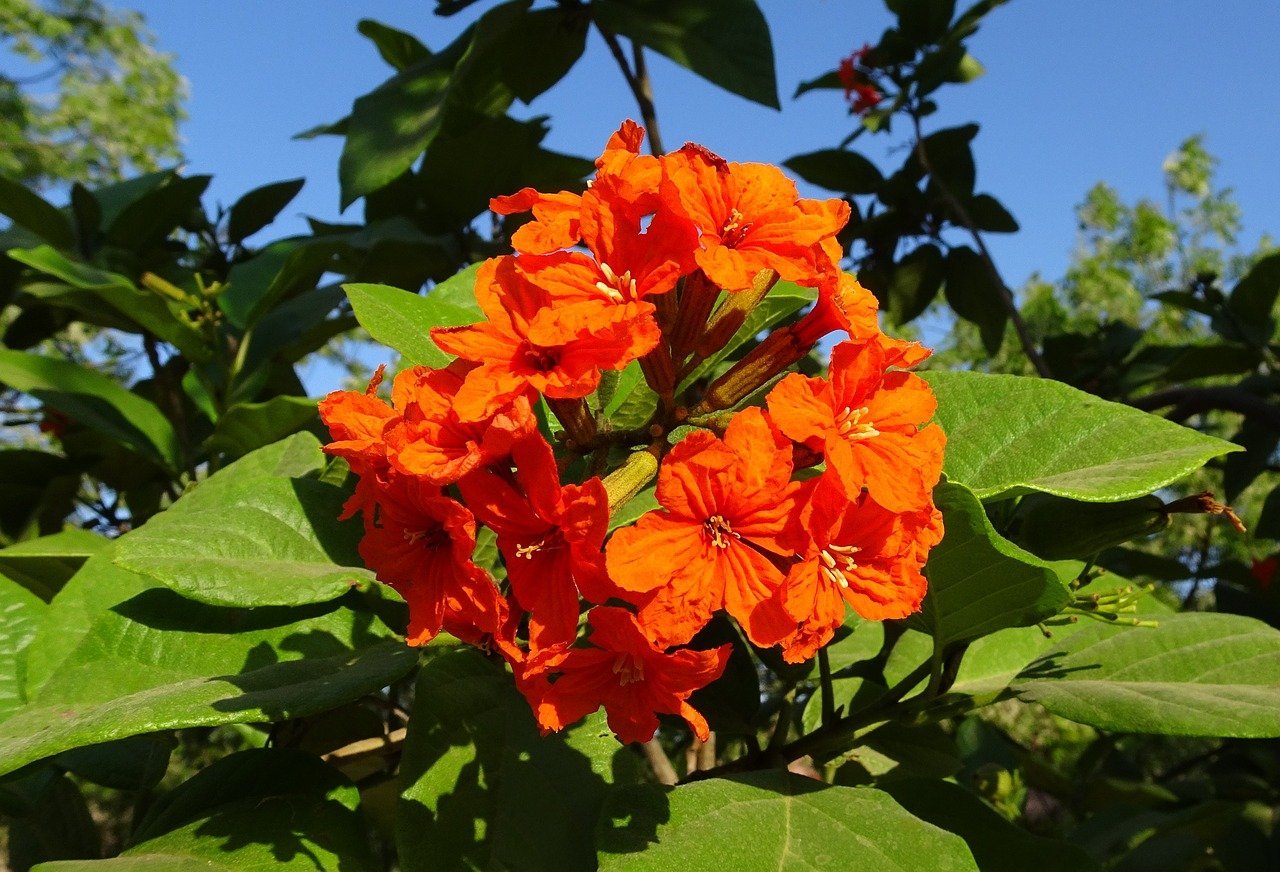Appreciating the Value and Beauty of Biodiversity
The Geiger Tree/Cordia Sebestena
May 30, 2019
This will be my last column for the season, so I'm recapping some of the important issues addressed so far.
The U.N. report just released on the imminent loss of 1 million species worldwide underscores the need for each of us to do our part to restore the ecosystems in which we live.
We all need to:
Reduce the amount of broad-spectrum chemicals we pour on our landscapes, which not only kill beneficial organisms essential to soil and plant health but also leach into our aquifers;
Plant more native species, as these support the high protein butterflies and insects necessary for all our birds, 90 percent of which are endangered;
And restore biodiversity in our landscapes by adding a variety of species and discouraging monocultures, which endanger wildlife habitat. Whether we live on multi-acre estates or in tiny apartments, we must understand that every plant counts, and numerous small gardens can have a major collective impact.
Butterfly gardens can be a source of wonder, enlightenment and great joy. It’s such fun finding caterpillars and determining which butterflies they will become by the plants on which they are feeding. Every butterfly requires a specific host. Plant milkweed, and you will have monarchs; plant corkystem passion flower, and you will have zebra heliconians, Gulf fritillaries and Julias. Finding the chrysalis and watching the process of metamorphosis up close is truly amazing — how those silly fat caterpillars become glorious, graceful butterflies is a miracle to us, but just another day for Mother Nature.
Having diverse, colorful, fragrant landscapes that support an abundance of birds, butterflies and pollinators is much more interesting than having a green lawn or entryway. And in creating these diverse gardens, you provide the ecosystems essential to the insects that are the foundation for life as we know it.
Here are a few more terrific native and Florida friendly plants that will enhance your gardens and support healthy ecosystems; they all withstand drought, wind, salt and poor soil, and none require pesticides or fertilizers.
Trees
Gumbo limbo (Bursera simaruba) is one of my favorite trees, with spectacular smooth, cinnamon-bronze colored peeling bark. Fast-growing in sun or shade, it will reach a height of 60 feet, providing shade where needed. It can be propagated by simply sticking a cut branch into the ground. While this is deciduous for a short period in late winter, small white flowers at that time attract pollinators, and the fruits are loved by many birds.
The Geiger tree (Cordia sebestena) is easily recognized by its showy bright, orange/red flower clusters throughout the year. This is a lovely small tree growing to about 20 feet. Its flowers attract hummingbirds and butterflies.
Dahoon holly (Ilex cassine) is a medium-sized tree with glossy dark green leaves and stunning, bright red berries in fall and winter, loved by songbirds. This will thrive in almost any landscape, in sun or part shade. Being dioecious, the berries are borne on the females; so make sure to plant a male specimen nearby to ensure fruit.
Shrubs
Necklacepod (Sophora tomentosa), with its multiple tall spikes of yellow, pea-like flowers, is a magnet for butterflies and hummingbirds and is the larval host for the martial scrub hairstreak. Tough, hardy, growing to 5 feet, this is ideal for coastal landscapes.
As previously mentioned, saw palmetto (Serenoa repens) and Bahama senna (Senna mexicana var. chapmanii) are great attracters for pollinators. Senna, also known as cassia, is a larval host for the orange barred sulphur and cloudless sulphur; its bright yellow flowers are lovely year-round. Saw palmetto is a tough, beautiful, trouble-free addition to any landscape; its flowers attract the rare, endangered atela butterfly and its leaves host larvae of monk and palmetto skippers. The fruit is a nutrient-rich food source for more than 100 species of birds, pollinators and mammals. In full sun or part shade, and even the poorest soil, this looks great bordering a driveway or as a hedge mixed with other natives.
Flowers
Native perennials will enhance biodiversity and add splashes of color to your landscape.
Rosinweed (Silphium integrifolium), Tickseed (Coreopsis), wild allamanda (Pentalinon luteum) and black-eyed Susans (Rudbeckia) are great yellows.
Blues and purples are found in azure sage (Salvia azurea), indigo spires (Salvia farinacea x longispicata), ageratum (Conoclinium coelestinum), porterweed (Stachytarpheta jamaicensis), beach verbena (Glandularia maritima) and beebalm (Monarda punctata). Two non-natives, blue plumbago and blue daze (Evolvulus glomeratus), are also good pollinators, thriving in full sun. Blue daze is a wonderful ground cover with silvery green leaves and ruffled blue flowers.
For native whites, try buttonsage (Lantana involucrata), scorpion-tail (Heliotropium angiospermum) and white indigo berry (Randia aculeata). Non-native whites that are still Florida-friendly are jasmines, white plumbago, pentas, lady of the night (Brunfelsia americana), Wrightia and the wonderfully fragrant sweet almond bush (Aloysia virgata).
Native reds, pinks and oranges are found in firebush, (Hamelia patens var patens), tropical sage (Salvia coccinea) and coral honeysuckle (Lonicera sempervirens). Non-natives red rocket (Russelia sarmentosa) and Panama rose (Arachnothryx leucophylla) are excellent nectar sources.
Make sure to plant the corkystem passionflower (Passiflora suberosa), a terrific native vine that will grow up the sides of palms or other trees to add depth and interest to the landscape. This is the host for the zebra longwing (heliconium), Julias and Gulf fritillaries, and the caterpillars are exquisite: white with black spikes for the zebra. The maypop (Passiflora incarnata) is another much showier passionflower with fragrant, ornate flowers from spring through fall. Another host for the same butterflies, this tough vine will grow to 20 feet up trees or along fences.
Most importantly, remember that insect herbivores provide food for all other species. By reintroducing the native plants that support these insects, we can restore the biodiverse ecosystems necessary to sustaining life on our planet.
— Kim Frisbie
Original article on the Palm Beach Daily News is HERE.







